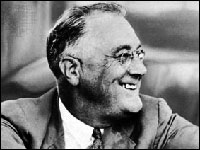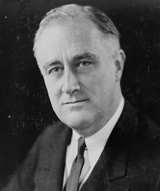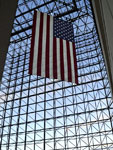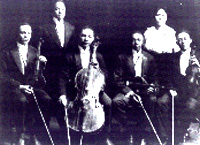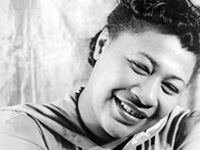Columbia University professor Raymond Moly wrote most of Roosevelt’s speech, and talked over his initial drafts with the president-elect. Several days before the inauguration, Moly delivered a typescript of his final draft to Roosevelt, who was staying at the Mayflower Hotel in Washington, D.C. Roosevelt went over the speech then with Moly and copied it out in longhand. The line about “fear itself” was not in the speech at that point. Before leaving FDR’s hotel suite, Moly burned his typewritten draft in the fireplace.
Louis Howe
The next day, former newspaperman and Roosevelt’s long-time close confidante, Louis McHenry Howe, arrived in Washington. According to Howe’s assistant Lela Stiles, a few days previously, Howe had talked with a newspaperman and friend about difficulties that the country faced, and during the conversation Howe told his friend, “I don’t care what else Franklin says in his inaugural address as long as he tells the people that the only thing they have to fear is fear.”
When Howe arrived in Washington, FDR gave him his handwritten draft of the speech. Howe made his own changes and additions and had a secretary type a new draft. One of Howe’s changes had been to add the line, “So first of all let me assert my firm belief that the only thing we have to fear is fear itselfnameless, unreasoning, unjustified terror which paralyzes the needed effort to bring about prosperity once again.” FDR liked Howe’s addition, but then, on the draft, changed the end of the sentence, from “to bring about prosperity once again” to “needed efforts to convert retreat into advance.” These were the words he used when he delivered the speech several days later at the inauguration, on March 4, 1933.
FDR liked Howe’s addition, but then, on the draft, changed the end of the sentence.
The Health of the Nation, the Health of FDR
Roosevelt’s revision of Howe’s sentence was in keeping with the revisions that he and Moly had made to earlier drafts. One of the guiding metaphors in the first versions of the speech had turned on comparing the country’s economic condition to a sickness, but Moly had ultimately decided that Roosevelt would be better able to inspire the nation to profound and wide-ranging action if he did not compare it to an invalid, but rather to an army preparing for war. The imagery of sickness in the early drafts yielded therefore to martial language in the last drafts. FDR’s change of Howe’s sentence followed along with this.
Nevertheless, the new version of the sentence still refers to fear and a rejection of being "paralyzed." Whatever else FDR conveyed to his listeners with this sentence, a message of reassurance about his own health was surely part of what they heard. Concerns about whether his polio had incapacitated him had sometimes surfaced during the election campaign and two weeks before the inauguration he had avoided the bullets of a would-be assassin.
Frances Perkins, who served as FDR’s Secretary of Labor, reminisced in 1946, more than a decade after the speech, about Roosevelt coming to terms with his having contracted polio in 1921. She wrote, “He learned in that period and began to express firm belief that the ‘only thing to fear is fear itself.’ He never displayed the slightest bitterness over his misfortune.” Perkins was a little unclear here about whether she was referring specifically to Roosevelt in the decade before he became president, and whether she really meant to place the exact phrase “the only thing to fear is fear itself” in his mouth during that time.
Henry David Thoreau?
If Roosevelt had in fact often expressed those words, it is difficult to understand why his closest colleagues and even his wife Eleanor did not assume that he had thought them up himself and inserted them into the inaugural address, but looked elsewhere for the ultimate source of the expression. When FDR’s associate and sometimes-speechwriter Samuel Rosenman asked Eleanor about the expression, she ventured that her husband may have found something very much like it in a volume of Henry David Thoreau’s writings, which she thought he must have had with him in his hotel suite in Washington.
Thoreau had written the sentence, “Nothing is so much to be feared as fear,” in his journal entry for September 7, 1851, in passing, as part of his comment on his contemporaries’ criticisms of Harriet Martineau’s arguments for atheism in her just-published Letters on the Laws of Man’s Nature and Development. Ralph Waldo Emerson later quoted his young friend approvingly, and the phrase was indeed included in later collections of Thoreau’s writings.
Newspaper Ad?
Professor Moly, however, pointed directly at Louis Howe as the proximate source, and doubted that Howewhose reading habits focused on detective novelshad found the Thoreau quote. He later told William Safire, “I do clearly remember that the phrase appeared in a department store’s newspaper advertisement some time earlier in February. I assume that Howe, an inveterate newspaper reader, saw it too. …" To Howe’s everlasting credit, he realized that the expression fully fitted the occasion.”
"To Howe’s everlasting credit, he realized that the expression fully fitted the occasion."
Moly's reference to department store advertisements sounds like the campaign used by Wanamaker’s. During the first few months of 1933, Wanamaker’s department store placed large display ads in The New York Times. The ads included a small box with inspirational messages of business and commercial platitudes or sentiments “from the founder’s writings,” those of John Wanamaker, who sometimes quoted people like Benjamin Franklin or George Washington. I do not see any of ads for the first two months of 1933 in which Wanamaker quoted Thoreau or anyone else expressing precisely the statement about “fear itself,” nor do I see a quote of Wanamaker venturing the phrase himself. However there are many platitudes there about confidence, cheerfulness, a positive attitude, persistence, honesty, and integrity. Perhaps Professor Moly saw an ad that I have been unable to locate.
Diagnosing the Health of the Nation's Businesses
The phrase “The only thing to fear is fear” did have some currency at the time among businessmen. Julius Barnes, the Chairman of the Board of the National Chamber of Commerce, for example, gave a news conference in early February announcing the organization’s effort to promote efforts to stabilize business suffering during the depression. The conference was reported by The New York Times on February 9. One of the subheadings of the article was “Fears Most Fear Itself,” and quoted Barnes as saying, “In a condition of this kind, the thing to be feared most is fear itself. Confidence, tempered with prudence, is necessary to the operation of even the most perfect business mechanism. The retarding effect of a sense of insecurity is promptly communicated from worker to consumer, from consumer to producer and the whole machine stalls, and the anticipated evil becomes.”
Many in the business community were in fact convinced that the country was suffering from a kind of psychic sickness, caused not by systemic problems in industry or banking, but by the nation’s irrational lapse into fear, which had caused an economic paralysis. It was the fear itself that needed to be exorcised. FDR’s predecessor, Herbert Hoover, also often spoke in this way.
By this metaphor, the nation was an invalid who had been afflicted with a mental problem, a paralysis of action. Its thinking somehow had to be turned around, toward a positive confidence. By changing the patient’s thinking, his body would naturally recover his mobility. The nation needed a mental healer.
The nation needed a mental healer.
New Thought
This sounds rather like the frame of reference of the quasi-religious “New Thought” or “Mind-Cure” or “Mental Science” Movement that blossomed in the United States in the late 19th and early 20th centuries. As William James described it in his 1929 work, The Varieties of Religious Experience, “The leaders of this faith have had an intuitive belief in the all-saving power of healthy-minded attitudes as such, in the conquering efficacy of courage, hope, and trust, and a correlative contempt for doubt, fear, worry, and all nervously precautionary states of mind.” The movement was defined not so much by an organizational form as by the common assumptions and themes of a group of writers who specialties included what we would today called “alternative medicine,” speculative psychology, and inspirational literature. Their writings are dominated by perorations on healing and success. The business community, then as now, had a fondness for “motivational” speaking and writing, especially as it might make a sales force more effective. It is likely not an accident, therefore, that the head of the Chamber of Commerce would be diagnosing the chief of the nation’s problems as fear.
In fact, the precise phrase, “The only thing to fear is fear,” occurs in the 1908 book, Thought Vibration; or, the law of attraction in the thought world, written by New Thought writer William Walker Atkinson. He counseled, “Remember, the only thing to fear is Fear, andwell, don’t even fear Fear, for he’s a cowardly chap at the best, who will run if you show a brave front.” In 1918, Atkinson wrote The Power of Concentration under the pseudonym of Theron Q. Dumont, in which he declared, “There is no justification for the loss of courage. The evils by which you will almost certainly be overwhelmed without it are far greater than those which courage will help you to meet and overcome. Right, then, must be the moralist who says that the only thing to fear is fear.”
Another “New Thought” writer, the “naturopathic doctor,” Henry Lindlahr, wrote in his 1919 book, Practice of Natural Therapeutics, “Avoid fear in all its forms of expression; it is responsible for the greater part of human suffering. The only thing to fear is fear.”
Businesses had invoked these precise sentiments around the time they were published, during the domestic economic pinch prevalent during World War I, for example. On the 4th of July, 1917, the musical instrument firm of Edward Droop and Sons in Washington, D.C., paid for a large display ad in The Washington Post, under the large headline, “The Only Thing to Fear Is Fear.” The firm’s ad continued:
We refuse to be perturbed by the alarmists, the pessimists and by the timid who see things at night. As prophets in the past they have a batting average of about .001. The only times they have hit the truth is when they themselves created the conditions they feared by fearing them. Our slogan during these earnest times is “Keep Business Going.” We shall retrench in nothing, cancel nothing, fear nothing. Our faith in the existing and eternal prosperity of the United States of America is immovable. … We believe that this is the very time of all times that you should buy what you wantwhether it be in our line or in any other. The only way to stop your business is to stop the other fellow’s. The only thing to fear is fear.
The phrase “The only thing to fear is fear” and its variants, therefore, were demonstrably “out there” in circulation within the business community during the first few decades of the 20th century. William Safire makes the point that it does not really matter where the phrase came from because it was FDR that used it during his speech to inspire the nation and it was he, therefore, who transmuted the linguistic coin into rhetorical gold.
